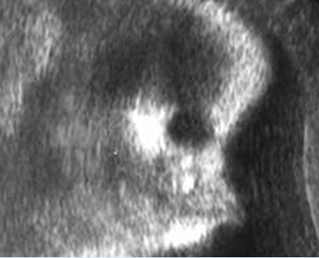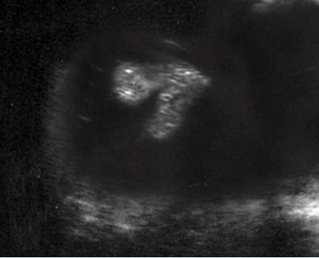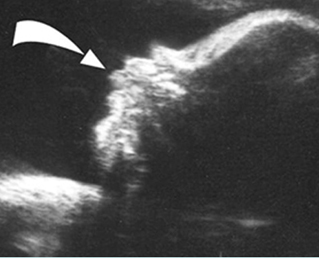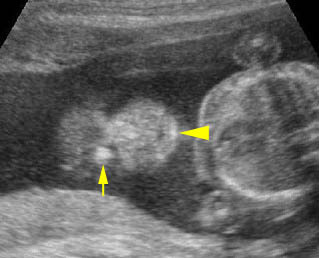Other Abnormalities

Fig 1: Small nose Small nose related to fetal trisomy 13

Fig 2: Abnormal ear shape Abnormal ear shape in association with Down syndrome

Fig 3: Macroglossia Facial profile view: persistent protruding tongue (arrow) (in fetal Down syndrome)
Video clips of other abnormalities

Cataract: Coronal scan of the face shows hyperechoic lens (arrow) (arrowhead : chin)
Other rare disorders of the head/neck may be found on facial examination such as cataract, absent or small nose, abnormal facies, or abnormal ear configuration.
Fig 1, Fig 2, Fig 3
Diprosopus
Diprosopus is a very rare form of conjoined twins, consisting of a single neck and body and a spectrum of duplication of craniofacial structures, ranging from isolated duplication of the nose to complete facial duplication.
Sonographic findings:
- Two faces with a fused head, fused neck.
- One nose or two noses, four orbits or three orbits (the middle two orbits are fused together).
- Double lines of spinal cords, but only one set of other structures.
- Abnormally-shaped skull.
- Disorganized intracranial structure.
- Two pairs of thalami is common.
Associations: Duplication disorders in several structures.
Management: Termination of pregnancy should be offered.
Prognosis: Poor.
Recurrence risk: Rare.
Cataract
Cataracts can develop in fetuses infected with TORCH and can be associated with a number of syndromes. The prenatal diagnosis of cataracts has been made largely among patients at increased risk for cataracts in their offspring. The ultrasound findings are a small round echogenic mass in the anterior aspects of the eye, in which the usually thin-walled, rounded, cystic lens appears solid and completely echogenic.

